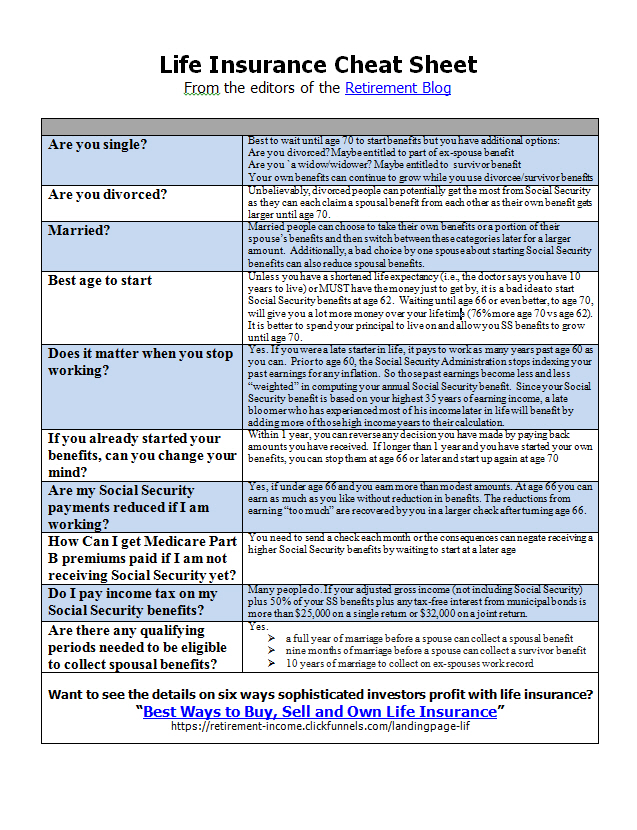Even those with few assets must attend to estate financial planning or else, your assets can get distributed to people you did not choose. Those who ignore estate financial planning cause tremendous heartache to heirs when the heirs:
- they cannot access bank accounts
- cannot access a safe deposit box
- cannot sell a property
Non-Financial Reasons for Estate Planning
Most people hear "estate planning" and immediately think of the rich. Here are the non-financial issues for people to do estate financial planning:
- Do you want input into how you'd like to be taken care of when you become incapacitated?
- Do you want to be sure that your assets go to the people you choose when you die?
- Would you like to eliminate or minimize needless loss of some or all of your assets when you need long-term care?
- Do you want to prevent public exposure, costs, and delays of probate?
These are important questions and virtually everyone will answer 'yes' to all of them. Making arrangements to satisfy each question is what your estate plan is all about.
But what's especially important is making arrangements to address these questions ASAP because of these 4 circumstances:
1. You never know when you'll die
2. You never know when you'll become mentally incapacitated
3. You never know when you may need long-term care
4. Arranging satisfactory solutions to some of these questions requires 3 to 5 years lead time - at least - before these circumstances occur!
Consequences of not addressing these questions are (i.e. no estate plan, no trusts):
- You're treated in a manner you would never wish to be when incapacitated.
- Someone other than your choice determines how your money is used and distributed.
- Your assets go to someone, not of your choice.
- With no will or trust, your assets will be distributed according to state rules – not your wishes.
- Without a trust, you must trust your current spouse to give assets to your previous children
Can Your Estate Be Settled in a Timely Fashion?

You’ve worked hard all of your life to provide for your family and loved ones. You've completed your estate financial planning. Now you can relax knowing that your heirs will be taken care of once you are gone. Or will they? If you are assuming that your assets and personal effects will automatically go to your spouse, you may be in for a surprise.
Even if you have a proper will, it will not protect your estate from intestacy (which means that no clear heir has been designated) and probate. At the point your will is to be administered, your assets must undergo a process called probate. This is a standard estate financial planning process that will provide a clear title to your heirs and pay off all debts and other obligations as called for in your estate plan.
Avoid Probate

Probate will also legally prevent any creditors from bestowing their claims onto the heirs. However, while the probate process does provide a clear title of assets to heirs, virtually all of the decisions made regarding how this estate planning process is accomplished will be determined either by state law, or else the decision of an impersonal judge, if there is any kind of disagreement among your prospective heirs as to how your assets should be distributed. There are a number of reasons why estate financial planning should avoid probate, if at all possible.
This probate process is completely open to the public. Anyone who wishes to find out everything about your estate once you are gone will have complete freedom to do so. Thanks to modern technology, a complete listing of your assets and estate plan will probably be available online for the world to see.
As stated before, probate is totally beyond your control--and the control of your spouse or other prospective heirs. You may assume that all assets will simply go to your spouse, but this is usually not the case. Most states will automatically divide your assets equally between your spouse and your children, regardless of whether your children are ready to take ownership of their share.
Probate also offers anyone wishing to contest your will an opportunity to do so. This, of course, can lead to expensive legal proceedings that drag on for months. The costs involved in this will also be borne by your heirs.
There are many possible expenses that can be incurred in the probate process, including court costs, appraisal costs, executor’s fees, legal and accounting fees, and even surety bond fees in some cases. The typical cost of probate can often run between three to seven percent of the value of the estate (and much more in some cases.)
One solution is to use a revocable living trust, the most commonly used tool by those who understand sound estate financial planning. Another is joint ownership as explained and cautioned below.
Should You Add Your Adult Child's Name to Your Accounts?
Retirees sometimes add their child’s name to their accounts in an effort to transfer ownership and remove assets from their estate. This is never a good idea in sound estate financial planning.
First, you aren’t realizing any tax savings, if needed, by putting your child's name on a bank or brokerage account—i.e., registering it as joint tenants with rights of survivorship (JTWROS). JTWROS assets bypass the probate court process upon your death and go directly to the surviving joint tenant, so there will be fewer time delays and court costs. However, the account will still be included in your estate.
Moreover, adding your child’s name to your account could expose you to legal woes—and leave you without any money for retirement. Let’s say you’re getting older, and you aren’t able to manage your affairs well, so you add your adult child’s name to your bank and brokerage accounts. Your child can write checks on the accounts, and if you die, he or she will inherit the accounts, avoiding probate.
But there could be problems that estate financial planning avoids. First, since assets registered as joint tenants with rights of survivorship are owned jointly during your lifetime, they thus can be accessed (and liquidated!) by your joint tenant while you are living. In other words, your child could potentially liquidate the account without your consent.
Perhaps more worrisome: If your child gets sued, you could lose all of your money. And don’t think you can change the title of the assets once legal proceedings begin—that’s called fraudulent conveyance, and it a big legal no-no.
For the above reasons, better estate financial planning avoids having any assets held s JTWROS. A better option may be a durable power of attorney, which gives your child access to your accounts without placing the assets at risk.
Why Joint Ownership With Anyone Can Put Your Assets at Risk

Probate is the legal process of wrapping up a person's affairs, paying their bills, and distributing their assets. And it is not uncommon for this to take several months to go through the court system. The expenses involved can potentially include property appraisal, executor fees, court costs, plus legal and accounting fees. The amount varies depending on your state and the local practice in your community.
To avoid this burden on their loved ones, seniors frequently transfer assets into joint-tenancy ownership with their intended beneficiaries. Although this strategy can reduce settlement costs by eliminating estate planning probate, it could open up another set of problems.
Assets held in joint-tenancy automatically go to the surviving owner when you die. However, while you are alive, the joint owner can legally withdraw part or all of the money in the account without your permission. In addition, if he or she gets into financial or legal trouble, the property could be at risk to creditor claims.
Rather than making a beneficiary a joint owner of your property to simply avoid probate, you might consider another idea.
An individual can own certain assets and list a beneficiary. At the owner's death, the assets pass to the named beneficiary and avoid probate. While you are alive, your beneficiary does not have access to your account. You can change beneficiaries at any time, and you might even be allowed to name a contingent beneficiary.
Payable-on-Death (POD) and Transfer-on-Death (TOD) is Better than Joint Ownership
A Payable on Death (P.O.D.) registration applies to a bank, savings and loan, and credit union accounts, as well as United States savings bonds. On the other hand, a Transfer on Death (T.O.D.) registration is used for securities such as stocks, bonds, and mutual funds (but only if the securities firm allows it). The POD and TOD designations are some of the simplest and most powerful tools in estate financial planning.
Note--Not all banks accept POD designations; You just need to check.
With both of the above, POD and TOD, the beneficiary receives the assets by offering proof of identity and a copy of your death certificate, regardless of the provisions in your will. Please note that the assets will still be included in your estate when you pass away.
Every state except Louisiana and Texas allows TOD designations stocks, bonds, or brokerage accounts without probate. However, fewer states permit TOD for real estate.
What About Real Estate Owned with Children?

Home ownership is one of the fundamental ingredients of the American Dream. It provides financial wellbeing, increases access to additional credit, adds to a person’s pride, and fosters stability. And for seniors who want to help their children or grandchildren achieve this goal, there may be rewards for them as well.
Interest rates are low. Therefore, now could be an ideal time to consider buying a home for the kids. You can make this an investment by purchasing an apartment building, a duplex, or other multi-family dwellings. Your child could live in one unit, and the other units would provide rental income to you. Nevertheless, the property will become part of your estate. And if you give it to your children, it will be subject to gift taxes. There are, however, some other ideas that you might want to consider.
One approach would be to loan the children the money to buy the house. The house and mortgage should be in their names so it is not included in your estate. You could be the lender, and the children would pay you back over time. The interest rate that you charge your children can be lower than they would get from a bank or mortgage company. But to keep the IRS from declaring your loan a taxable gift, you may want to use the applicable federal rate. Your children will still end up with low-cost financing and a tax deduction for the mortgage interest paid to you.
A tax-free gift to help with the down payment is another option. You are allowed to give $15,000 a year to as many people as you wish without paying the gift tax. Therefore, you and your spouse could give $30,000 to each child. And if they are married, that number can be as high as $60,000. Then to increase it more yet, you could give them $60,000 towards the end of the year and the same amount at the beginning of the next. With $120,000 in hand, they should be able to make a nice down payment and you will have reduced the value of your estate.
While estate financial planning must account for estate taxes, these taxes hardly apply. Only those estates in excess of $5.6 million ($11.2 million in the case of a marries couple) are subject to estate tax. However, your State may levy an inheritance tax on your heirs. Check on this as it may be possible in your plans to reduce or avoid it.
Will Your Beneficiaries Be Able to Manage the Wealth They Receive from Your Estate?
 No one likes to think about it, but it’s an important decision that all individuals should make: how to plan for the transfer of your assets when you die. Wills and trusts are critical tools for this function, designed to pass your wealth along to a surviving spouse or another generation as efficiently as possible. But do your beneficiaries have a plan as to how they’ll manage the assets they will receive?
No one likes to think about it, but it’s an important decision that all individuals should make: how to plan for the transfer of your assets when you die. Wills and trusts are critical tools for this function, designed to pass your wealth along to a surviving spouse or another generation as efficiently as possible. But do your beneficiaries have a plan as to how they’ll manage the assets they will receive?
Complete estate financial planning accounts for the transfer of your wealth and also considers how that wealth will be managed once it is placed in your beneficiaries’ hands. In some cases, the designated beneficiary might not have the wherewithal to manage a large sum of money on their own. Therefore, you may want to establish instructions for the management of your inherited assets while you are alive. That way you can help ensure that your surviving spouse or other beneficiaries will have financial support for the rest of his or her life.
Leave Heirs a Gift of Lifetime Income
 Many people do their estate financial planning with an eye toward protecting and enriching the next generation.
Many people do their estate financial planning with an eye toward protecting and enriching the next generation.
One strategy you might consider for your beneficiaries: have the inherited IRA assets placed in a fixed immediate annuity. This could provide a lifetime guaranteed income for your surviving spouse or other beneficiaries. Assets from an IRA can be transferred into an annuity tax-free, although income taxes will be due on distributions and are required to begin according to the beneficiary’s life expectancy.
An immediate annuity might work well for a beneficiary who is inexperienced in financial matters or would prefer the security that the guaranteed stream of income from the annuity would provide. Payments could be set up to pay for health insurance or long-term care insurance premiums. And additional riders can cover specialized needs such as cost-of-living increases, or a cash refund of the balance of the annuity to a designated beneficiary upon the death of the annuitant.
Please note that annuities are designed for long-term investing and ordinary federal income taxes and a 10% tax penalty will apply to withdrawals taken prior to age 59½ (except in the case of the annuity owners or annuitants death).
Annuity benefits and guarantees are based upon the claims-paying ability and financial strength of the underlying insurance company and are not government insured. Additionally, one should remember that surrender charges could apply to early withdrawals and are often based upon the time the insured has been invested in the annuity. Annuity surrender schedules also vary from company to company.
Titling Real Estate in Second Marriages

Second marriages likely create the most heartache when estate financial planning is not completed.
Children from the previous marriage could be cut out of any inheritance. Or if older documents were never changed, the current spouse could get nothing.
If you’re in a second marriage, you may face a conundrum: You want to share ownership of property with your new spouse, but you also want your children from your first marriage to inherit your share of the property when you die. Can you solve this dilemma with estate financial planning?
When married couples have joint assets, they often title these assets as joint tenants with rights of survivorship (JTWROS). If this is the case with you and your spouse, when you die, your spouse will inherit the asset—regardless of what your will says.
Some other options—particularly for couples with children from previous marriages—are tenants in common and tenants by the entireties.
When assets are titled as tenants in common, each person owns half of the asset. For example, you might title a primary residence as tenants in common with your spouse, and at your death, pass your interest in the property to a child from your first marriage. But there are numerous problems with this scenario. First, you don’t avoid probate. Second, each party’s creditors (your child’s and your spouse’s) have access to the assets. Third, your child will have to wait until your second spouse dies to fully inherit the property—a potentially uncomfortable situation.
Thus, real estate may be more appropriately held as tenants by the entireties. This option, which is only available to married couples for their primary residence, attributes the whole asset to both parties. The advantage is that it protects the property from claims against one spouse by creditors or litigants: A creditor of one of the spouses may not (under certain circumstances) attach the tenancy by the entireties assets unless both spouses are indebted to the creditor.
But there are also some downsides to titling assets tenants by the entireties. First, getting the title switched may call for some effort. Titling an asset this way is not permitted in all states, so national custodians may not include tenants by the entireties as an option on application forms. If you feel that is the way to go, you may need to spend some time on the phone with the custodian.
Also, tenancy by the entireties immediately terminates upon divorce or death. Let’s say a judgment exists against you, and your spouse unexpectedly dies. The property that you thought was protected through tenancy by the entireties has, in the blink of an eye, become subject to the claim of your creditors. And any attempt you make to transfer the property could be deemed “fraudulent conveyance”—a concept too complicated to get into here, but we assure you, would result in many estate planning and legal problems.
The Role of Life Insurance in Estate Financial Planning

If your spouse dies and you are the beneficiary of his or her life insurance policy, you can usually accept the proceeds in one of three ways:
- in a lump sum,
- in fixed payments over a specified period of time, or
- in an annuity, you establish that makes regular payments to you for the rest of your life.
Lump-sum payments—receiving all the money at once—are generally appropriate for small policies, or for those beneficiaries who are capable of investing wisely, or who can rely on competent investment advisers. Lump-sum payouts occur automatically when insurance proceeds are payable into a trust.
If you don't need all the money right away or don't want to worry about investing it, you may choose to take the benefits in fixed payments for a specified number of years, such as 10 or 20. Or, you may want to annuitize the payments to guarantee monthly or annual payments to you for life. The last two alternatives make sense if you want the security of a steady income.
If you are the designated beneficiary of the policy, you needn't wait long to receive the death benefit. Just file any necessary life insurance claims as quickly as possible. No waiting period is required. Life insurance companies usually pay routine death benefits within weeks.
The life insurance death benefit will add to the estate value of your spouse if he owned the policy. However, it bypasses probate since you are the beneficiary and not he.
The life insurance proceeds would only go through probate if no one was named the beneficiary or the estate was named. In this case, the life insurance company would issue the check to the probate court. The probate process is long.eventually the court will distribute the proceeds of the estate after probate and attorney fees are paid. Only then will it distribute the remainder according to the will of the deceased or by the laws of intestacy of the state if there was no will.
Taking the payout in fixed installments-- perhaps monthly or quarterly--may be a reasonable approach. You can have the insurance company distribute the proceeds and interest in regular installments over a fixed period of time until the money is used up. If you have not received the entire payment by the time you die, the unpaid balance will be paid to either your estate or a beneficiary you choose.
You may also ask the insurer to make fixed payments to you of only the interest that the death benefit proceeds generate. You can leave the principal to your estate or designate a beneficiary to receive it when you die.
Steps Your Heirs Should Take
After Death -- a Post Death Estate Planning Checklist

After a loved one’s death, particularly that of a spouse, it’s hard to focus on financial affairs—but there are a number of things that must be done to settle the deceased’s estate. Here’s a checklist.
Obtain copies of the death certificate from the funeral director. You’ll need five to 10 certified copies as proof of death when transferring assets and filing for life insurance proceeds.
Locate important documents. These typically include the most recent will, investment account information, and insurance policies. But it’s easy to miss some obvious papers, so also check the deceased’s most recent tax return to help identify investments and other information, as shown in the chart below.
Important documents checklist
- Will
- Investment account information (and stock certificates, if applicable)
- Insurance policies
- Safe deposit boxes
- Business agreements
- Real estate deeds
- Recent copies of income tax returns
- W-2 forms and other records of earnings
- Social Security card or number
- Marriage and birth certificates
- Military discharge papers
- Veterans Administration claim number
- Automobile registration
- Installment payment books
Gather all current bills. You’ll want to call the companies issuing the bills to find out if they’re covered by credit life insurance, which pays off the account balance in the event of a customer’s death.
Contact the deceased’s life insurance agent. Typically, to establish proof of claim, life insurance companies require only a beneficiary’s statement and a death certificate or attending physician's statement. You don’t even have to decide what to do with the money right away: Some life insurance companies offer interest-bearing money market accounts that let you write checks against your benefit proceeds while you talk things over with your advisors.
Contact organizations. Unions, service organizations, and other professional organizations the deceased belonged to may offer special death benefits.
Contact the Social Security office. If the deceased was covered under Social Security, you may be eligible for a lump-sum death benefit, particularly if you’re the surviving spouse.
Meet with advisors. Finally, obtain the services of professional advisors—such as lawyers, accountants and financial advisors—who will make sure that your records are in order and see that your wishes are met. And remember, you aren’t just wrapping up your loved one’s death; you’re preparing for your new life, which means you should update accounts and policies to reflect changes in ownership, draw up a new will, and plan for your own financial future.
Do Your Heirs Know to Disclaim Gifts to Fix Estate Financial Planning Errors
 Sometimes you should look a gift horse in the mouth.
Sometimes you should look a gift horse in the mouth.
Thanks to the U.S. tax code, the cost of receiving a gift may outweigh the benefits in which case the renunciation or disclaiming of that gift may be a wise course of action.
A disclaimer is a refusal to accept a gift or inheritance. Once you disclaim a gift or inheritance, it will be, from a gift and estate tax perspective, as if you had never received the disclaimed property.
In most cases, beneficiaries will use the disclaimer for estate tax reasons. The disclaimer is a powerful estate financial planning tool as it allows assets to bypass a generation of taxation, say a spouse bypassing an inheritance in favor the children.
A valid disclaimer must be a) written, clearly identifying the asset and refusing it, c) delivered before the beneficiary takes possession of the assets, and within nine months, and c) signed by the person disclaiming the asset. Additionally, and the asset also is passed on to another party without any direction from the person disclaiming the asset.
That last point is what makes disclaiming assets so interesting. Let's say you're beneficiary of an estate: Your spouse died and left everything to you but nothing to your children. So, if don't need all of the inheritance, you can disclaim part and allow the assets to pass directly to children. In this example, estate financial planning does not concern taxes but rather, who gets what.
Note that we said "part." That's because you can choose to accept specific items or portions of a gift/inheritance and disclaim the rest.
As simple as it sounds, disclaiming is quite valuable, because it's one of the only estate planning tools that allow a decedent's estate plan to be analyzed, and adjustments to be made, retrospectively. And it can be used in a number of sticky situations.
As a hypothetical example, suppose that Mr. Smith has creditor problems, and any assets he receives from the death of his brother would immediately be subject to the claims of those creditors. By allowing the assets to pass to his or her children, Mr. Smith could ensure that they wouldn't be accessible to creditors.
As another hypothetical example, say that Mr. Smith and Mrs. Smitheach own 50 percent of a family business, which they want to pass on to their son. When Mr. Smith dies, Mrs. Smith inherits his portion. Mrs. Smith disclaims the inherited stock, passing it on to her son. She then redeems her shares, making her son the sole stockholder.
If you're thinking of disclaiming an asset, be sure to talk to a financial advisor first, as it can get tricky. For example, the use of disclaimers to avoid creditors' claims is not always foolproof, as some court precedents and state laws may prohibit it. Complete estate financial planning also includes notification to beneficiaries, while you are alive, that they can disclaim the inheritance.
Questions? Leave them in the comments below.

Leave a Reply